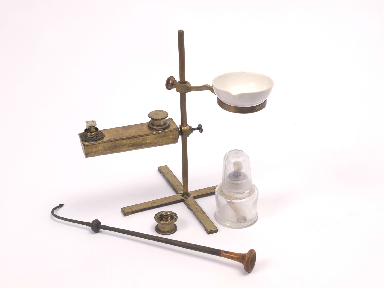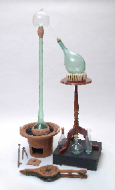Issue 53 highlights antique apparatus used in physiological chemistry for the analysis of urine.
Click here for all other issues of Notes from the Oesper Collections and to explore the Jensen-Thomas Apparatus Collection.


A portable Berzelius oil lamp for blowpipe analysis. The additional ring and alcohol lamp could be used to evaporate mineral water samples for analysis.
Issue 52 highlights items in the Oesper Collections related to the practice and teaching of blowpipe analysis.
Click here for all other issues from the Oesper Collections and to explore the Jensen-Thomas Apparatus Collection.
On November 13 a major new release of Scholar@UC became available.
The Scholar@UC 3.0 upgrade includes some exciting new features: Continue reading
Scholar@UC is undergoing an upgrade! On Oct. 19 or soon after, Scholar@UC will freeze content to undergo a planned migration to an upgraded platform, “Scholar 3.0”. During the freeze, all content including works, collections, and user profiles will be available but read-only; submitting new content will not be possible during this time. The content freeze is projected to last a little over one week (restoring full access on October 30th or soon after). Once the migration is complete, an all-clear email will be sent out and new content contributions and changes can resume.
The Scholar@UC 3.0 upgrade includes some exciting new features: Continue reading
A recent article by Danniah Daher, graduate assistant to the Graduate School Office, entitled Scholar@UC: The Archive You Need, talks about the need to preserve and protect scholarly work and research data by submitting it to the university repository. Linda Newman, head of digital collections and repositories, is quoted as saying, “The mission of Scholar@UC is to preserve the permanent intellectual output of UC…We are very serious about preservation. We’re also very serious about access. We want to make the content accessible—content that otherwise would just be sitting on someone’s hard drive in their office. We consider preservation and access our two most important jobs.”
The full article can be read online at http://grad.uc.edu/student-life/news/scholaratuc.html.
Available at https://scholar.uc.edu/, Scholar@UC is a digital repository that enables the University of Cincinnati community to share its research and scholarly work with a worldwide audience. Faculty and staff can use Scholar@UC to collect their work in one location and create a durable and citeable record of their papers, presentations, publications, datasets, or other scholarly creations. Students, through an approved process, may contribute capstone projects such as senior design projects, theses, and dissertations.
The mission of Scholar@UC is to preserve the permanent intellectual output of UC, to advance discovery and innovation, to foster scholarship and learning through the transformation of data into knowledge, to collect a corpus of works that can be used for teaching and to inspire derivative works, and to enhance discoverability and access to these resources.
The University of Cincinnati Libraries is seeking a Digital Lab Manager (a 3-year renewable position). The successful candidate will direct the operations of a digital lab in a university research library, including digitizing rare books, manuscripts and special collections, managing digitization projects and workflows, maintaining equipment and software, providing quality control, and supervising student assistants. This is an exciting opportunity to join a dynamic and diverse organization in a great university, great city, with high potential for interesting technical work.
Evaluation of candidates begins on September 21, 2017. The University of Cincinnati is an EE/AA employer. For more information and application instructions see: https://jobs.uc.edu/job/Cincinnati-Digital-Lab-Manager-OH-45201/425512200/.

A reproduction of a circa 17th-century alembic
with an “ostrich”-necked cucubert, clay luting, various
receiving flasks, charcoal furnace, bellows, tongs, and poker
The 45th issue of Museum Notes gives a brief history of the oldest known distillation apparatus as illustrated by various reproductions found in the Oesper Collections.
Click here for all other issues of Notes from the Oesper Collections and to explore the Jensen-Thomas Apparatus Collection.